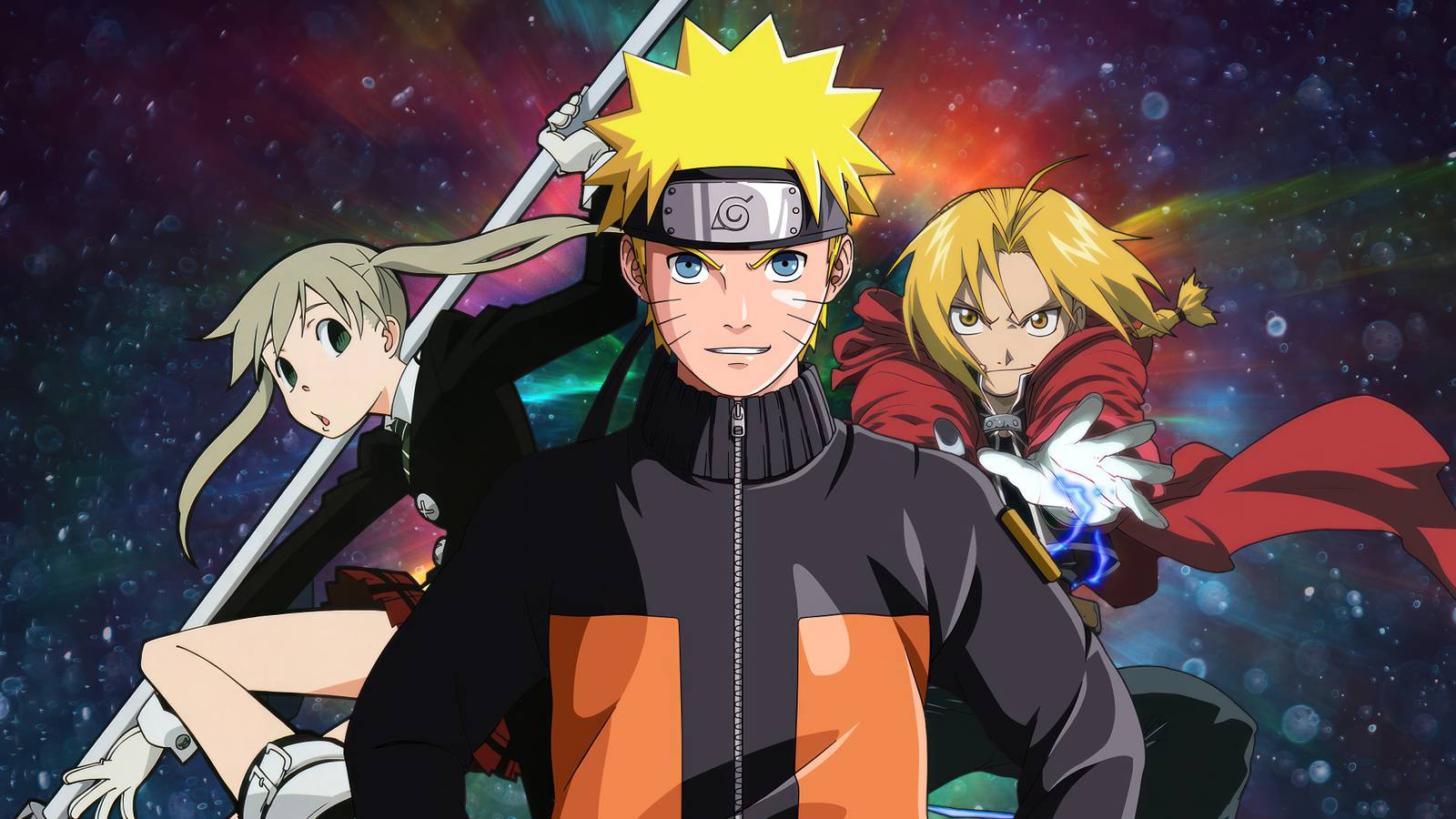The 2000s was a great decade for anime. While many still wax nostalgic about the classic titles of the 80s and 90s, it's getting to the point where millennials are starting to look back fondly. For some, considering a series that aired in 2002 as a “classic” anime might be a scary thought, but we're at the point where many series from that era are looked back on fondly.
Shonen anime has always been popular and the 2000s was a great time to be a fan. Aside from the absolute classic titles that we still love to this day, the decade also had some solid series that could be overlooked. Here's a quick look at the best shonen anime from each year of the 2000s.
2000: I Love Hina
Battle Shonen may often be what fans think of when you mention “Shonen” anime, but some of the most popular titles in the world's biggest Shonen magazines have been romantic comedies and harem series. Before major titles like Love Ru and Nisekoi became WSJ staples, there was Weekly Shonen Magazine's I love Hina.
The series is a pretty straightforward harem. It follows Keitarou Urashima, who, after failing to get into Tokyo University and fulfill a childhood promise, is convinced to help run his grandmother's inn. When he gets there, he discovers that it has actually turned into a girls' dormitory, home to five unique residents. Keitarou gradually develops a relationship with the girls while continuing to work towards fulfilling his promise.
2001: Bucky the Grappler
Before Netflix brought the series back with 2018 Bakithere was the original Bucky the Grappler anime that aired in 2001. While it definitely has a loyal fan base, it always feels like an often overlooked series.
The series follows the titular Baki Hanma as he spends his young life training his body to the limit with one goal in mind: to ultimately defeat his father, the fearsome Yuujirou Hanma. Dubbed as the strongest man in the world, Baki faces an uphill battle and eventually sets out to find new opponents to hone his skills in preparation for the final showdown with his father.
2002: Naruto
One piece narrowly missed the cut for a 1999 premiere, but you can bet the rest of the WSJ “Big Three” will make this list. To start things is Narutoa series that has maintained its popularity with anime fans around the world for decades.
The series follows the titular Naruto as he works to become Hokage and earn the respect of the people of his hometown. With over 700 episodes, Naruto is definitely a time commitment. But the investment is worth it.
2003: Cromartie High School
Popular shonen anime often contain comedic elements, but there aren't many that are pure comedies. Cromartie High School is a series you may never have heard of, but you can be sure that it will be one of the funniest anime you watch.
Despite having the grades to get into any high school he wants, Takashi Kamiyama enrolls at Tokyo's infamous metropolitan Cromartie High School, home to some of the toughest delinquents in the country, in order to accompany his less academically gifted high school friend. When his friend fails the ridiculously easy entrance exam, Takashi tries to change the school for the better.
2004: Bleach
It shouldn't surprise anyone to see another “Big Three” streak here. Although it may not have had the same lasting success as One piece and Naruto, Bleach is still an iconic anime from the 2000s that is experiencing a bit of a renaissance thanks to The Thousand Year Blood War anime.
The series follows Ichigo Kurosaki, who has a unique ability to see ghosts. After meeting a girl from another world named Rukia who is hunting a soul-eating creature known as a Hollow, Ichigo is drawn into a conflict between Hollows and Soul Reapers tasked with defeating them.
2005: Negima!
Negima! is one of those series that was big while it was still running, but didn't hold much relevance. Still, it's a 2000s shonen classic that serves as an interesting time capsule.
The series follows 10-year-old Negi Springfield, who must pass one more test to become a Magister Magi. However, as a final test, Negi is given a special task; is assigned to teach English at a girls' school in Japan. Naturally, things get off to an awkward start, but Negi works hard to adjust to his new role while learning more about his students and ultimately solving the mystery of what happened to his missing father.
2006: Death Note
While it may seem a bit darker than what most would normally associate with shonen anime, Death Note was one of the biggest series in the WSJ during its three year run. The series serves as an excellent introduction to anime and a solid title to sit down and enjoy if you've never gotten around to experiencing it.
Death Note follows Light Yagami who, after finding the titular Death Note and encountering a Shinigami named Ryuk, decides to create a utopia by killing criminals with the power of the mysterious book. But as things unfold, it becomes clear that this newfound divine power is affecting the Light in terrible ways.
2007: Gurren Lagann
With titles like Neon Genesis Evangelion by Kare Kanoand Nadia: The Secret of Blue Water under their belt was the now defunct Gainax responsible for some of the most iconic anime of the 90s. Although their work in the 2000s was less prolific, the studio was able to strike gold again with 2007. Gurren Lagann.
Gurren Lagann follows friends Simon and Kamina who are forced to live in an underground village. When they come across the ignition key for an ancient suit they call the Lagann, the two travel to the surface world to face the Spiral King and his beasts who fight in giant suits called “Gunmen”.
2008: Soul Eater
If any classic shonen from the 2000s deserves a remake, this is it Soul Eater. Bones' 2008 adaptation is a classic but very similar to the original All Metal Alchemistran out of source material and the manga adaptation was never completed.
The series takes place in Death City, where the students of the famous Death Weapon Meister Academy work to make things called Death Scythes, weapons that Lord Death uses to fight various monsters in their world. The student body is divided between the meisters who wield and raise these weapons to their full potential, and the students who have the power to transform themselves into demonic weapons. Soul Eater follows a trio of meisters and their demon weapon sidekicks as they battle evil foes and work towards their ultimate goal of creating/becoming the Death Scythes.
original All Metal Alchemist the anime was great, but its biggest gripe was that it didn't fully adapt Hiroma Arakawa's iconic manga. Enter 2009 Brotherhood, a series that is not only considered an amazing adaptation of its source material, but one of the best anime of all time.
Brotherhood follows the Elric brothers who meet dire consequences after trying to use alchemy to bring back their deceased mother through human transmutation. Ed, the older of the two, loses an arm and a leg due to the ritual, while his younger brother Alphonse loses his body completely and his soul is trapped in the metal armor. Now with a new goal, the brothers set out to find the legendary Philosopher's Stone and restore their bodies.
-

Naruto
- Release date
-
2002 – 2007-00-00
- Showrunner
-
Masashi Kishimoto
- directors
-
Hayato's date
- Writers
-
Masashi Kishimoto
- Franchise(s)
-
Naruto
-

Bleach
- Release date
-
2004 – 2012-00-00
- Network
-
TV Tokyo, TV Osaka, TV Aichi, TVh, TVQ, TSC, BS TV Tokyo
- Showrunner
-
Tite Kubo
- directors
-
Mitsutaka Noshitani, Junya Koshida, Hodaka Kuramoto, Yasuto Nishikata, Hiroaki Nishimura, Kazunori Mizuno, Akira Shimizu, Rokou Ogiwara, Kazunobu Shimizu, Akane Inoue, Hikaru Murata, Tomoko Hiramuki, Hatakeyama Shimiki, Tatakeyama, Egami, Nogami Nishi, Takushi Kimura, Koji Aritomi, Ogura Shirakawa, Kiyomu Fukuda, Yukio Okazaki, Mitsue Yamazaki, Yasuhiro Matsumura, Eitarou Yes
- Writers
-
Masahiro Okubo, Masashi Sogo, Kenta Shimoyama, Genki Yoshimura, Kazuyuki Fudeyasu, Rika Nakase, Michiko Yokote, Natsuko Takahashi, Kento Shimoyama
-

Masakazu Morita
Ichigo Kurosaki (voice)
-

Fumiko Orikasa
Rukia Kuchiki
